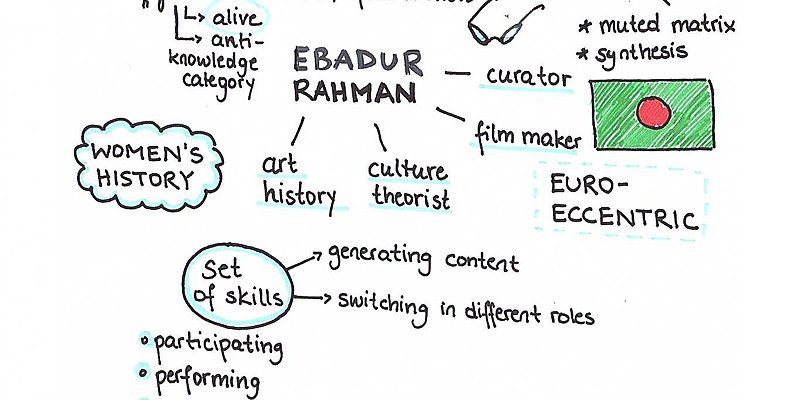Goddesses in South Asia
Ebadur Rahman
The metropolitan hybridization and, presentification of 33 Million gods and goddesses, in South Asia, are stabilized by strict hierarchy—this cathexis by division of labor and status, as it were, are constructed and conciliated in the complex and interpenetrating binary and rivalry of great goddesses and, minor mother deities, while the high pantheon is male focalized.
While the genealogy of some of the Great Goddesses e.g. Kali renders the distinction between Aboriginal and Aryan indeterminate; and Great Goddess Durga too is democratized and domesticated in the Bengal region, but, it is the minor mother Goddesses which, in the quotidian cultural experience and practice, temporilize the stagings of their being in and of the local oikos by working as affective technologies to traffic transcendent to the immanent, removing even the thin veil between supernatural and natural—and thus making the phenomenal constantly merging with and impregnating the ordinary—to the extent that, worshiping these mothers foment important decolonizing, modernizing and even romantic-fascist social forces.
Here, I’m advancing that, when the Maha Devi— the great goddesses—of the male imaginary recedes in the realm of big festivals and corporate sponsored temples, the minor mothers in their intimate biotic sphere, inaugurates an economy of contamination: not only everydayness is contaminated by the transcendental but the devotee of the minor mothers activate these goddesses by propitiating the vegetable and animal worlds: gestures and rituals begins at the courtyard, at the podium of the tulsi tree; offerings are made to snakes, frogs, turtles and rain clouds; rice pudding with cinnamon paste is fed to the farming land; minor mother Manasha, the goddess of snake, Sitala the goddess of Small pox or Ola Bibi the folk cholera-goddess’ index of bhabas—affective essences— engender a communal transference circuit for and produce affective relationships with the women who sustain South Asian rural societies. Perhaps, more importantly these minor mothers inaugurate a tightly structured counter-theology of Puranic syncretism in the intersection of not only Hinduism, Islam, Buddhism, Janism and indigenous animist religions, but open up the horizon of episto-affective feelings, from a polyphonic culturility rather than from within a system of belief; cross-gendered bhabas: cultural and social practice of men affecting feminine, identity crossing, trance, minstrel-nomadism become ways to gain minor mothers’ intimacy to access the technology of affects and, towards the presentification of these affects into the language and the social.
Background:
The South Asian mother goddesses—contiguous with the Nina or Isthar in Babylonia, among the Western Semites, the great Hittite Goddess of Boghaz-Keui or to some extent the figure of the great mother backgrounding the representations of the Minoan and early Hellenic théogonie are bifurcated in the Aryan and Dravidian pantheons: In the Aryan Veda based practices and beliefs, not unlike in Babylonia, ritual goddesses are subservient—except in the cases of great goddesses Kali, Durga, Saraswati, Devi—to the gods while the older Dravidian pantheon exalt goddesses and the feminine principles in nature.
In my discussion of the living goddesses, I will attempt to employ the cult of Saptamatrika—the Seven Heavenly Mothers—as a lens to interrogate the unbroken continuity and liquescence—the juxtaposition of the location of power and the sites of resistance without borders— of these Bronze Age figures depicted on the Indus Valley seals and, the terra-cotta plaques, from both Harappa and Mohenjo-daro archeological sites, crystalizing and evolving through ages as Matrikas blended with symbolism of Yoga and regarded as the Saktis of various Chakras; Buddhist Bhajrayana or Diamond vehicle of the Kushana period; during the Pala period, the golden age of Buddhism, the Seven Divine Mothers were installed in the Budhdhist Iconography so much so that, during 9th to 11th century A.D. during which the cult of Seven Mothers flourished in East India, the powerful Buddhist goddess Hariti was recognized as one of the Matrikas. Similarly during the 18th and 19th century, South Asian Nationalist leaders not only reformulated Saptamatrika to mobilize the anti-colonial movements but enfolded an Irish firebrand feminist revolutionary and, even a Algerian-French women in the pantheon of minor goddesses.
In the process, I will also, interrogate Mantra—formulas of Goddesses; Yantra—schematic diagrams of Goddesses; Sanskrit Stotra—hymnal material focusing on Goddesses; Bhakti, Shakta and Tantra and their foundational influences on both Eurasian avant-garde and fascism in the intervening years between the two great wars of the last century, the impact of which still reverberates in the globalized history of now.

